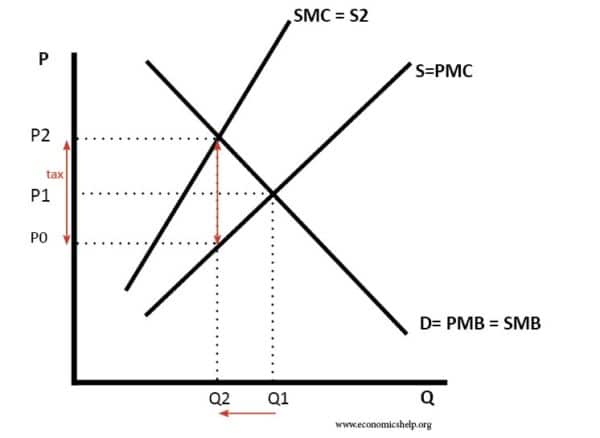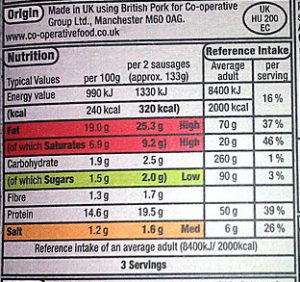Obesity has significantly increased in recent decades. It is seen as a serious public health issue as higher rates of obesity are associated with lower life expectancy and a rise in health issues, such as diabetes, heart disease, stroke and others. Countries across the world have tried different strategies to reduce poverty. This is an evaluation of these different policies tried in Chile, UK and Canada.
Policies to reduce obesity in summary
- Tax
- Warning labels on food.
- Restrictions on advertising.
- Restrictions on sale of unhealthy food.
- Information campaigns.
- Subsidisation / promotion of healthy food.
Tax
The idea of tax is to raise the price of unhealthy food and reduce demand.

From an economic perspective a tax can make consumers pay the full social cost of unhealthy food and provide an incentive to switch to alternatives. Tax on high-sugar, high-fat food also provide an incentive for firms to produce healthier foods with lower sugar/fat and therefore avoid the tax. In 2018, the UK government placed a tax on sugary drinks, depending on levels of sugar in the drink. After two years, researchers found a clear trend of lower demand for high-sugar drinks. But, they also noticed a marked shift of producers reducin sugar levels in drinks to avoid the tax.
In April 2018, before the tax was levied, 52% of eligible soft drinks contained 5g or more sugar per 100ml.
By February 2019, this ratio was only 15% of soft drinks were still liable.” (anti-obesity measures cut sugary drinks)
Another benefit of the sugar tax is that any tax revenue raised can be earmarked for spending on health care and treatment of obesity. Whilst there is reluctance to pay new taxes, if consumers are told, tax revenue will be earmarked for better health care, then it tends to be more acceptable.
Limitations of tax
- Whilst the UK example shows that a sugar tax can be effective, it is a mistake to see it as a panacea. One challenge is knowing and identifying which foods to tax. A tax on sugary drinks is relatively straightforward, but it ignores many other unhealthy foods high in fat, sugar and additives. Taxing sugary drinks is a start, but to be more effective the tax needs to be broadened all energy dense – to high fat/high sugar food. A tax on takeaways, crips or full fat cheese could become more bureaucratic and also unpopular.
- Also, demand for unhealthy foods may prove quite inelastic. In the absence of other policies and promotion of health alternatives, a higher tax only reduces demand by a small amount. It can be hard to change lifelong eating habits by tax alone.
- Furthermore others are concerned that a sugar tax will prove to be regressive as it takes a higher percentage of income from low-income households.
Restrictions on sale
A more straightforward policy is to ban the sale of unhealthy food in certain locations. For example, Chile has banned the sale of sugary drinks in schools. This is a direct way of limiting the availability of sugary drinks – a significant cause of childhood obesity. To be effective the policy needs the co-operation of schools and places of work. The government can set regulations for public schools, as countries such as Canada and Mexico have started to do.
This has shown to be quite effective in reducing consumption in certain areas and at a particular target of childhood consumers, but on its own is not enough to cause a significant change in eating habits.
Restrictions on advertising
In addition to regulations on sales, a government could place strict limits on advertising with companies restricted from advertising to children. For example, Chile’s strict anti-obesity legislation means food producers cannot use cartoon characters and unhealthy food cannot be marketed during hours when young children might be watching tv. Chile have banned images like Tony the Tiger on Frosties. This can make it easier to change long-term eating habits and is particularly important for very young children who have not yet formed strong eating habits and can be influenced by marketing.
The food industry has a vested interest in fighting these new laws. In Chile PepsiCo have taken the government to court, claiming the restrictions impinge on their trademarks. Opposition from powerful food manufacturers is an important issue. Companies have even begun to consider claiming it infringes trade rules like NAFTA
Food labels


Health warnings. Another policy is to educate consumers on the impact of food. This includes the use of warning labels about the health costs of different food items. In the UK, there are small labels showing the % of recommended daily allowance. So if you look at biscuit label you will see fat and sugar content and how much of the daily recommended it is. However, these labels are small and easy to ignore. Chile which once had highest rates of obesity in the world, chose to have very prominent labels on food and back – combined with an information campaign. These labels must be published on the front of packs an be in red/black to highlight the fact it is a danger to heatlh.
The amount of sugar, salt and fat allowed before labels are introduced is also being dropped in stages. This is to give firms and consumers time to adjust and reduce levels of sugar, salt and fat. The idea is to pressure firms into gradually reducing levels of sugar, fat and calories.
Evidence from Chile suggests these reforms have been very successful. Even in the first stage of reforms, sales of sugary drinks have fallen 23% – a bigger drop than other countries who adopted just a tax. Like the UK, firms have responded to regulations by changing the product
According to AB Chile, a food industry association, more than 1,500 items, or 20 percent of all products sold in Chile, have been reformulated in response to the law (NY Times)
These reforms also show that the nature of labels and food packaging is very important. When consumers buy food, it is often habitual. Even small nudges can steer consumer behaviour. Having simple, clear labels on food has changed the behaviour of many consumers. Even more important is the change it has on producers – creating a clear incentive to make food healthier. So far there is little evidence consumers have been demanding food with more sugar.
Education
An important aspect of food-labeling is that it provides an effective way to teach people about which foods are healthy and which are unhealthy. A study into the effect of Chile’s policies, found that many consumers expressed suprise that many foods they thought were healthy – actually contained very high levels of sugar/fat. For example, ‘health bars’, yogurts and cereal – which have very high levels of sugar.
“I associated that the brand Nutrabien (Goodnutrition) was very healthy, until those black labels came out. I realized that it had high levels of everything, and I felt very cheated (…) I really had no idea, I never paid attention. Now, I do pay attention.” Responses to the Chilean food label and advertising. (2019)
Evaluation
The success of education, labels and even tax may take time to have an effect. The study in Chile found that the most receptive consumers to change were young children, who were relatively quick to change habits and then put pressure on their mothers. Teens and adults were more reluctant to change their long-term eating patterns. However, as consumers get used to consuming healthier foods, cravings for unhealthy food diminishes.
The success of any policy also depends on how it is implemented. If food labels, tax are introduced alongside a change in policy at schools and work, it can lead to a change in food culture. If a policy is introduced in isolation, it may be ignored. There is an element of a bandwagon effect. When many children in class are beginning to choose healthier food, peer pressure promotes healthy eating, rather than peer pressure promoting fast food.
This can lead to some push-back. With parents feeling guilty about not giving healthy foods. There are also concerns that the prevalence of food-labeling may lead to desenitising and over time, people may come to ignore the labels.
Another issue is that companies have been reducing sugar by increasing artificial sweeteners – but artificial sweeteners may have health costs not entirely understood.
Related

You are missing one essential element to reducing obesity rates: increasing breastfeeding rates. Exclusive breastfeeding is associated with lower obesity rates, the first mile of healthcare, the first year of life is where interventions have the most effect. To increase breastfeeding rates you need investment in maternity care, lactation support and education of healthcare professionals in human lactation.
Then you need to implement the WHO code of marketing of breastmilk substitutes into national law. Ban all formula advertising, the most damaging and obesity inducing food of them all. I could go on.
Yes I agree you should try to promote breastfeeding because of all the benefits associated with this. But the issue with this is that not every mother is able to lactate, whether this be because of a lack of adequate supply that can feed the baby enough or whether this be due to health reasons such as HIV+ mothers who cannot breastfeed their children as it will pass down the virus to the baby so they must formula feed their children to avoid this happening. There are many more reasons for why a mother cannot breastfeed their babies and some other examples include: Mothers with active, untreated Tuberculosis; Mothers with HTLV Type 1 or 2 infection; Illegal drug use in mothers; Mothers receiving chemotherapy; Mothers receiving radiologic tests; Babies with Galactosemia (a rare genetic disease); and Babies with PKU etc. So they shouldn’t be penalised for this, what needs to be done instead is promoting better options of formula to include as many benefits as possible whilst still being safe too. Also formula milk is not the be all and end all of if you have formula then you will definitely become obese that isn’t always the case and vice versa with exclusive breastfeeding that if this happens then they cannot become obese as it still does happen. Yes promote breastfeeding when and where possible but if not then don’t make the mother feel bad for not being able to.